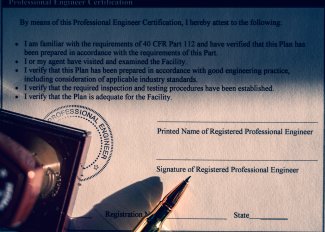Compliance and Standards

Price
Add to Cart
Overview
Process safety compliance is an important part of any Process Safety Management (PSM) program. These programs are mostly performance-based and non-prescriptive. They aim to help managers achieve high levels of safety, environmental performance and profitability. However, there are also many PSM regulations. This chapter describes some of these regulations and discusses how compliance can be achieved.
Process Safety Management (PSM) regulations are oriented toward helping managers achieve high levels of safety, environmental performance and profitability — in other words, they are performance-based. Nevertheless, PSM regulations do exist, and they have to be addressed. This chapter outlines general regulatory and compliance issues to do with PSM, particularly with regard to the United States OSHA standard.
In principle there should be no need for external rules and regulations — managers should strive to achieve process safety goals because they provide their own inherent reward. In practice, regulations are needed. Concerns to do with liability do influence behavior. Even in those facilities where management has the best of intentions there is always the temptation to put off safety and environmental work “until we have time”. A regulation will management’s feet to fire. If a plant has been running safely for many years, it is tempting to defer the rectification of hazards on the grounds that they have never been a problem in the past. Expenditures to correct these hazards do not lead to an immediate return on investment — they merely make an already low probability number even lower.
Table of Contents
Introduction
Regulations
Rule-Based Approach
Goal-Driven Approach
Process Safety Regulations
Codes and Standards
Development of a Standard
Standards Organizations
American Chemistry Council / Responsible Care®
American National Standards Institute (ANSI)
American Petroleum Institute (API)
American Society of Mechanical Engineers (ASME)
International Organization for Standardization (ISO)
National Fire Protection Association (NFPA)
Other Industry Sources
Center for Chemical Process Safety
Center for Offshore Safety
Chemical Safety and Hazard Investigation Board
Company Standards
Industry Information
Regulatory Guidance
Open Literature
Commercial Information
Analysis
United States Federal Regulations
The Regulatory Process
Code of Federal Regulations
General Duty Clauses
The Tenth Amendment to the United States Constitution
The Environmental Protection Agency (EPA)
The Occupational Safety & Health Administration (OSHA)
OSHA Inspections
Variances
Enforcement
The Entry Process
Fatality / Catastrophe
Programmed Inspections
Complaints
Citations
Willful
Serious
Other-than-Serious
Repeat and Failure-to-Abate
OSHA Standards
Part 29
Subparts of Part 29
Sections of Subparts
Interpretations and Guidance
The OSHA PSM Standard
Covered Processes
Other Standards
Audit Guidelines
National Emphasis Programs
Proposed Update
1. Atmospheric Storage Tanks
2. Oil- and Gas-Well Drilling and Servicing
3. Oil- and Gas-Production Facilities
4. Reactivity Hazards
5. Highly Hazardous Chemicals
6. Management System Elements
7. RAGAGEP
8. Definition of RAGAGEP
9. Safety-Critical Equipment
10. Organizational Changes
11. Emergency Planning
12. Third-Party Compliance Audits
13. Explosives, Blasting Agents and Pyrotechnics
14. Flammable Liquids and Spray Finishing
15. Ammonium Nitrate
16. Retail Facilities
17. Concentrations of Highly Hazardous Chemicals
The Environmental Protection Agency (EPA)
The EPA Risk Management Program - 40 CFR 68
Tiering / Program Levels
Covered Chemicals
Formal Management System
Worst Case Release
Alternative Release Scenarios
Lookup Tables
Emergency Plan
Five-Year Accident History
BSEE
State Regulations
New Jersey Toxic Catastrophe Prevention Act
Delaware/Nevada
The Safety Case Regime
Elements of a Safety Case
Duty-Holder Responsibility
Responsibility of the Auditor / Assessor
Risk Management System
Management Systems
Living Document
Structure of a Safety Case
1. Facility Description
2. Safety Management System
3. Formal Safety Assessment
Preparation and Implementation
Assessment
Performance Measurement
International Agencies
Elements of PSM
1. Employee Participation
Written Plan of Action
Consultation
Access to Information
2. Process Safety Information
3. Process Hazards Analysis
Initial Hazard Analysis
Methodology
Issues to Address
Team
Revalidation
4. Operating Procedures
Written Down
Initial Start-Up
Temporary and Emergency Operations
Certification
5. Training
6. Contractors
Application
Employer Responsibilities
7. Prestartup Safety Review (PSSR)
Process Safety Information
Construction and Equipment
Procedures
New / Modified Facilities
8. Mechanical Integrity
Application
Written Procedures
Training
Inspection and Testing
Deficiencies
Quality Assurance
9. Hot Work
10. Management of Change
Employer Responsibility
Written Down
Replacement In-Kind
Factors that Affect Change
Training and Participation / Accountability
Information Base
Operating Procedures
Making the Change
Training / PSI / Operating Procedures
11. Incident Investigation
Investigation
Timing
Team
Report
Follow Up
Participation
12. Emergency Planning and Response
13. Compliance Audits
Certification
Technical Qualifications
Report
Response
Retention of Reports

